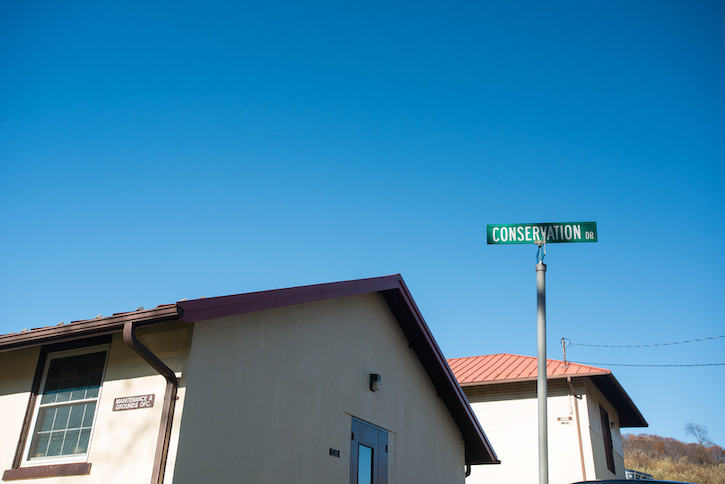“[Our mission is] teaching conservation through practice."
– Robert Barrett, Assistant Director of Recruitment and Outreach at SCBI
From the beautiful rolling hills to the on-site labs, the Smithsonian Conservation Biology Institute offers an extraordinary opportunity with hands-on learning experiences for all students interested in any aspect of conservation.
On October 21, 2019, George Mason students had the unique experience of touring the Smithsonian-Mason School of Conservation (SMSC) at the Smithsonian Conservation Biology Institute (SCBI). Located in Front Royale, Virginia, just along the border of the Shenandoah National Park, the preservation focuses on taking care of endangered species and researching ways to conserve and protect wildlife.
After arriving at the institute on “Conservation Day,” the group of Mason students boarded a van for a tour of the expansive area SCBI provides for their animals. Bill Clark, an employee at the institute, as well as our tour guide, began by recounting the original purpose of the land before becoming the Smithsonian Biology Conservation.

Clouded Leopard cub at SMSC. Photo provided by Evan Cantwell/Creative Services.
Opening in 1908, the location to be known as the Smithsonian Conservation was a United States Army Cavalry Remount Station. Here, horses were trained and bought to be used in the cavalry, infantry, pack and field artillery and transportation corps. Fast-forward to 1975, the Conservation and Research Center is established, now with the intention of helping a broader range of animals.
Today the 3,100 acres of land in Front Royal features pastures, streams, ponds, and forests for endangered animals to reside in as they are cared for and studied. On the tour, students were able to see a slew of animals, from Persian Onagers and Maned Wolves, to a Przewalski Horse and Micronesian Kingfisher. All of these animals are endangered or threatened, and not seen often in the wild.
“By the time you find out an animal is endangered, you usually don’t know enough about it and there are not too many left to study,” Clark says. “[Trying to learn more] is one of the things we do here.”
For conservation, most animals reside at the institute for reproduction purposes. One animal in particular, Walnut the Red Crown Crane, provided an extra challenge for scientists at the SCBI.
Attempting to find a suitable mate for Walnut had previously proved difficult when the Red Crown Crane took to killing her husband. Not wanting to risk another incident, the Smithsonian Conservation had birdkeeper Chris Crowe reenact the courting gestures of Walnut’s species. To everyone’s relief, Walnut accepted Crowe’s advances, allowing him to get close enough to artificially inseminate her, and earning her the name “The crane who fell in love with the human” from the Washington Post.
At the institute, elements like streams, Alfalfa fields, and Chinese bamboo are maintained to simulate the habitats familiar to the animal residents. Many of these habitats are disappearing, and often due to human activity; another project at SCBI focuses on discovering a solution.
The BiodiversiTREE Experiment is one of SCBI’s initiatives which plants different species of trees to discover what can survive in the area. This 100-year-old project looks to explore how forests react to climate change over a long period of time.
Adding to their efforts of protecting our environment, the SCBI also has set up a solar field, which produces 20 percent of the power the facility uses.
At the end of the tour, students met with SCBI’s Assistant Director of Recruitment and Outreach, Robert Barrett, for information on how to get involved at the institute through the Smithsonian-Mason School of Conservation program. “[Our mission is] teaching conservation through practice,” Barrett says. “Faculty favor teaching conservation as it’s practiced in the real world; there is a lot of experiential learning. You are actually using a lot of the tools and the techniques and the technologies of conservation, not just learning about them in a classroom setting.”
The Smithsonian-Mason School of Conservation (SMSC) offers three major undergraduate semester-away programs: Conservation, Biodiversity, and Society; Wildlife Ecology and Conservation; and Endangered Species Conservation. For each, students are provided housing on the SMSC campus, and face a mix of classes, research experiences, and job practicums as they work alongside other scientists. More programs and courses are offered over the summer, and graduate school and internship opportunities are also available for interested students.
Honors College junior, Marie Tessier, worked full time at the conservation through the Office of Student Scholarship, Creative Activities, and Research (OSCAR) program, and describes her time there: “It was a really awesome experience getting to work along scientists in the lab. [We were] working on stuff that’s never been done before.” At the institute, Tessier studied spermatogenesis - the production of sperm cells - with lambs.
“It really is an incredible place to study,” Barrett concludes, and it’s hard to disagree after touring the impressive conservation facilities. Clearly, the programs and facilities at the SCBI offer hope to many threatened animal species while providing meaningful opportunities for George Mason students to make a difference.

Photo provided by Evan Cantwell/Creative Services.
